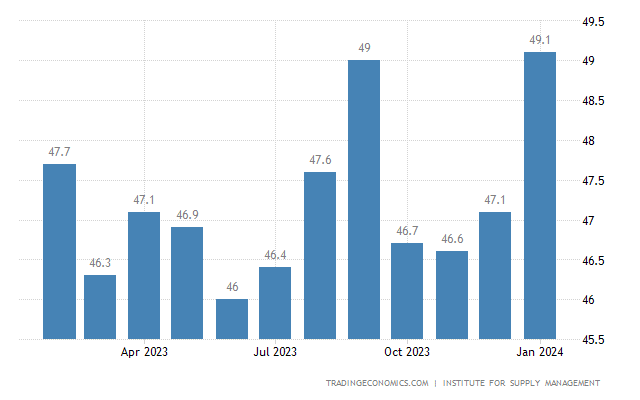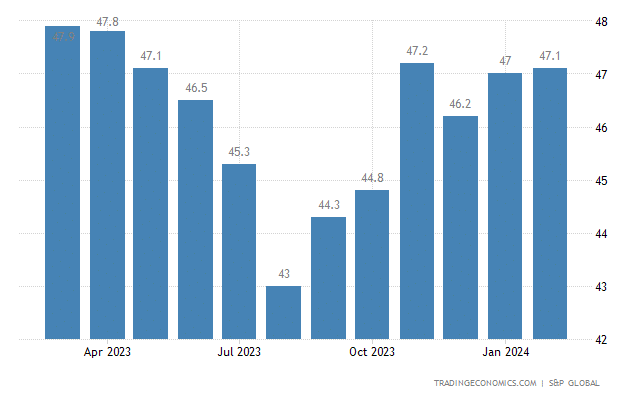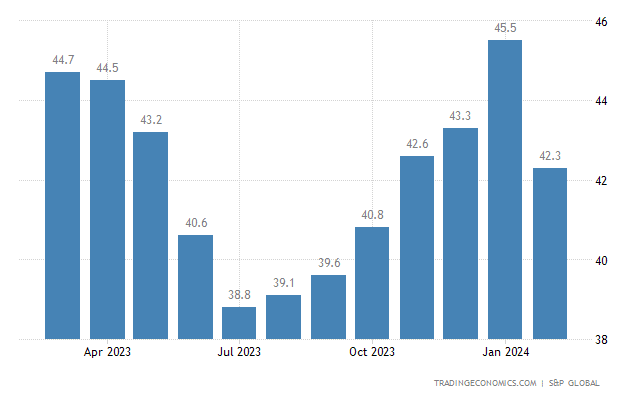What to Expect from US PMI data
The upcoming release of US PMI data is highly anticipated by analysts and investors, providing crucial insights into the performance of the manufacturing sector. S&P Global is set to release its Manufacturing PMI for February at 2:45 GMT, with expectations hovering around 51.5, matching the flash estimate reported earlier. This would mark a slight uptick from the previous month’s reading of 50.7, indicating continued expansion in manufacturing activity.
Meanwhile, the ISM Manufacturing PMI, scheduled for release at 3:00 GMT, is expected to come in at 49.5 for February, slightly higher than the previous month’s figure of 49.1. However, the ISM index is still expected to remain below the key threshold of 50, signaling contraction in the manufacturing sector.

Last week’s US Flash manufacturing data showed a positive trend, with a rise from 50.5 to 51.5, while the Flash Services PMI saw a modest decline from 52.4 to 51.3. As such, analysts will closely scrutinise the upcoming PMI releases for further insights into the health of the US economy and potential implications for monetary policy decisions.
What to Expect from UK PMI data
Investors and economists eagerly await the release of the UK PMI data, offering crucial insights into the country’s manufacturing sector. Scheduled for release at 9:00 GMT on Friday, March 1st by S&P Global, the UK’s Manufacturing PMI for February is expected to come in at 47.1, aligning with the previously reported flash estimate. The flash estimate of 47.1 was slightly lower than the consensus of 47.5, signalling potential challenges in the manufacturing industry.

This figure, although consistent with expectations, reflects a declining manufacturing sector and is similar to the previous month’s reading of 47.0. Although Service PMI matched last month’s reading at 54.3. Analysts will closely analyse the PMI data to gauge the extent of contraction or expansion within the UK manufacturing sector and assess its implications for the broader economy.
What to Expect from EU PMI data
Investors and analysts are eagerly awaiting the release of both German and EU PMI data, which will provide critical insights into the health of the manufacturing sectors in these regions. Scheduled for release by S&P Global on Friday, March 1st, the German HCOB Manufacturing PMI for February is expected to match the flash estimate of 42.3. This figure marks a significant decline from January’s reading of 45.5 and falls short of initial forecasts of 46.1. The data suggests a substantial downturn in the manufacturing sector, driven by reduced output and new orders, with the latter experiencing the most significant contraction since November. Additionally, job losses in the manufacturing industry have reached their highest level in three-and-a-half years, indicating underlying challenges.

Similarly, the EU HCOB Manufacturing PMI for February, also expected to align with the flash estimate of 46.1, highlights a concerning trend in the region’s manufacturing sector. This figure represents a decrease from January’s reading of 46.6 and falls short of market expectations of 47. The data indicates a continued decline in manufacturing output for the eleventh consecutive month, accompanied by significant drops in both new orders and export orders. Moreover, job losses within the manufacturing industry have accelerated, coupled with ongoing reductions in input buying and inventories. Analysts will closely scrutinise these figures to assess the broader economic implications and potential challenges facing the manufacturing sectors in Germany and the EU.
What is PMI Data?
Purchasing Managers’ Index (PMI) data is a widely used economic indicator that provides insights into the health and performance of a country’s manufacturing and services sectors. PMI data is derived from surveys conducted among purchasing managers in various industries, who report on factors such as new orders, production levels, employment, supplier deliveries, and inventories. These surveys are typically conducted on a monthly basis and compiled into indices by organisations like IHS Markit or the Institute for Supply Management (ISM) in the United States.
PMI data is presented as a single index number, usually ranging from 0 to 100, with readings above 50 indicating expansion in the sector and readings below 50 suggesting contraction. The higher the index value, the faster the rate of expansion, while lower values indicate a decline in economic activity. PMI data is further segmented into sub-indices for different sectors, such as manufacturing PMI and services PMI, providing a comprehensive view of economic activity.
The release of PMI data is closely watched by economists, investors, policymakers, and businesses as it offers valuable insights into the current state of the economy, some of which will try to trade the news. It serves as an early indicator of economic trends, helping to forecast changes in GDP growth, employment levels, and inflation rates. PMI data also influences financial markets, impacting asset prices, currency exchange rates, and monetary policy decisions by central banks. Overall, PMI data plays a vital role in assessing economic conditions and informing decision-making processes across various sectors.